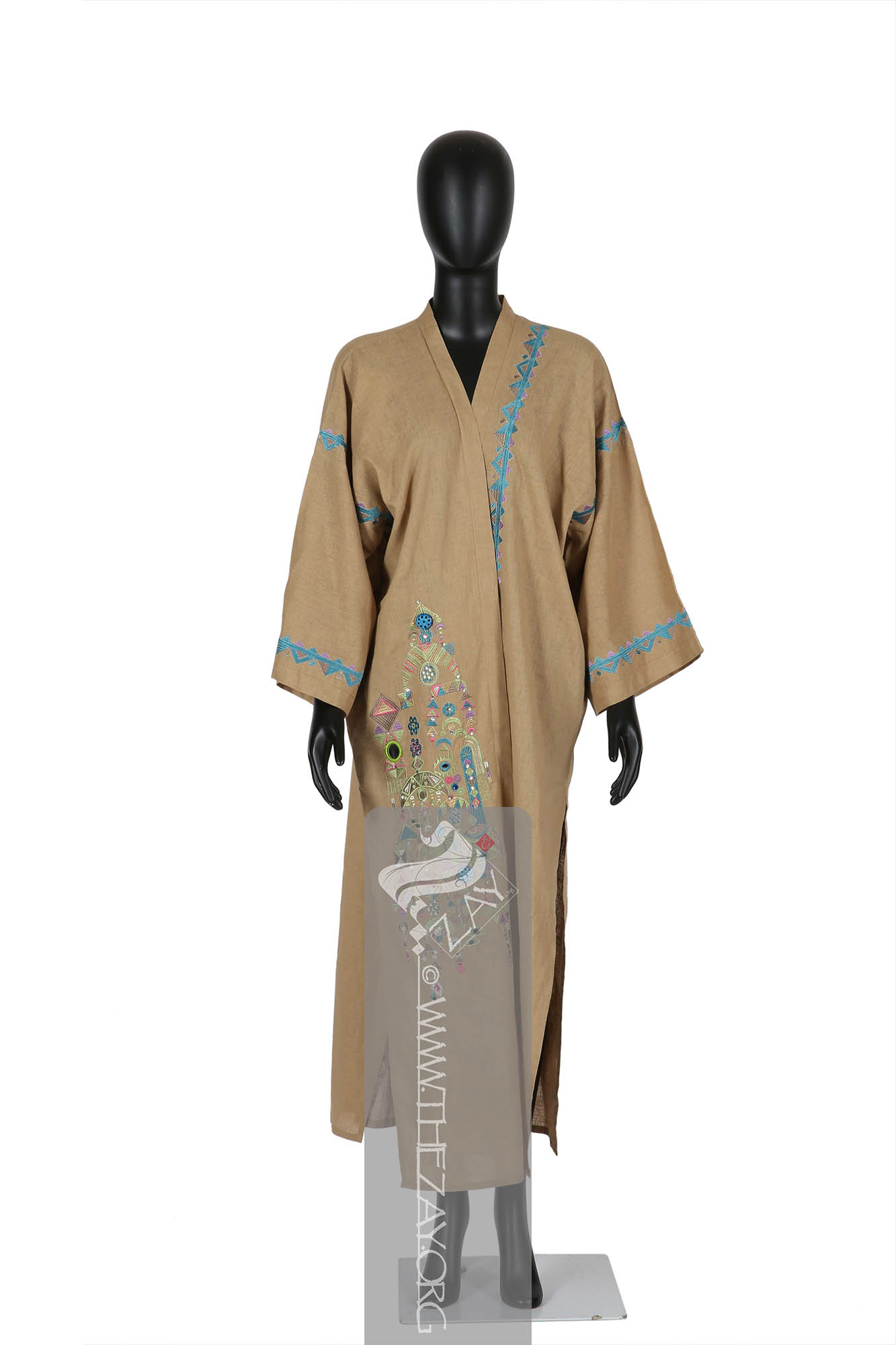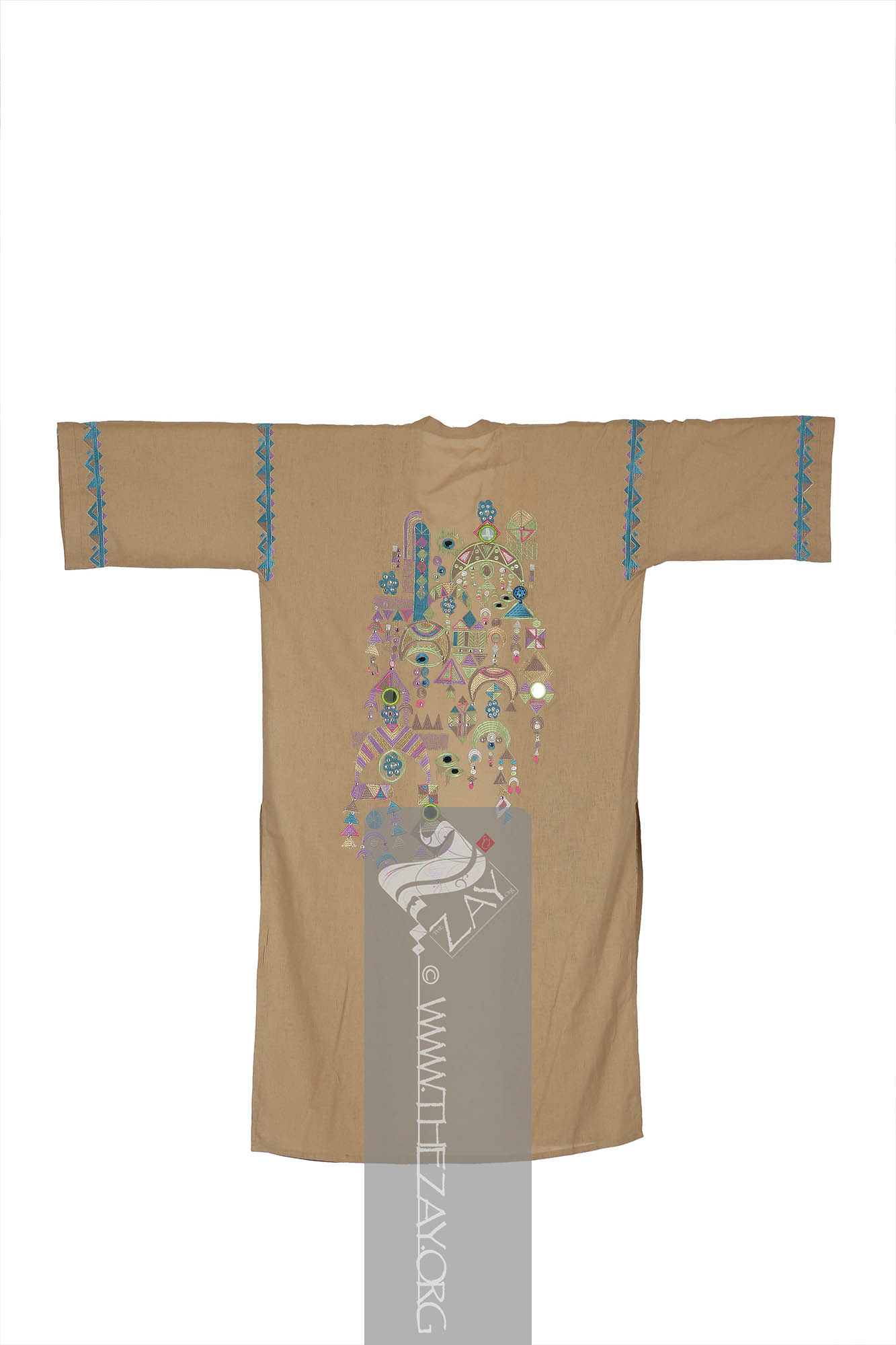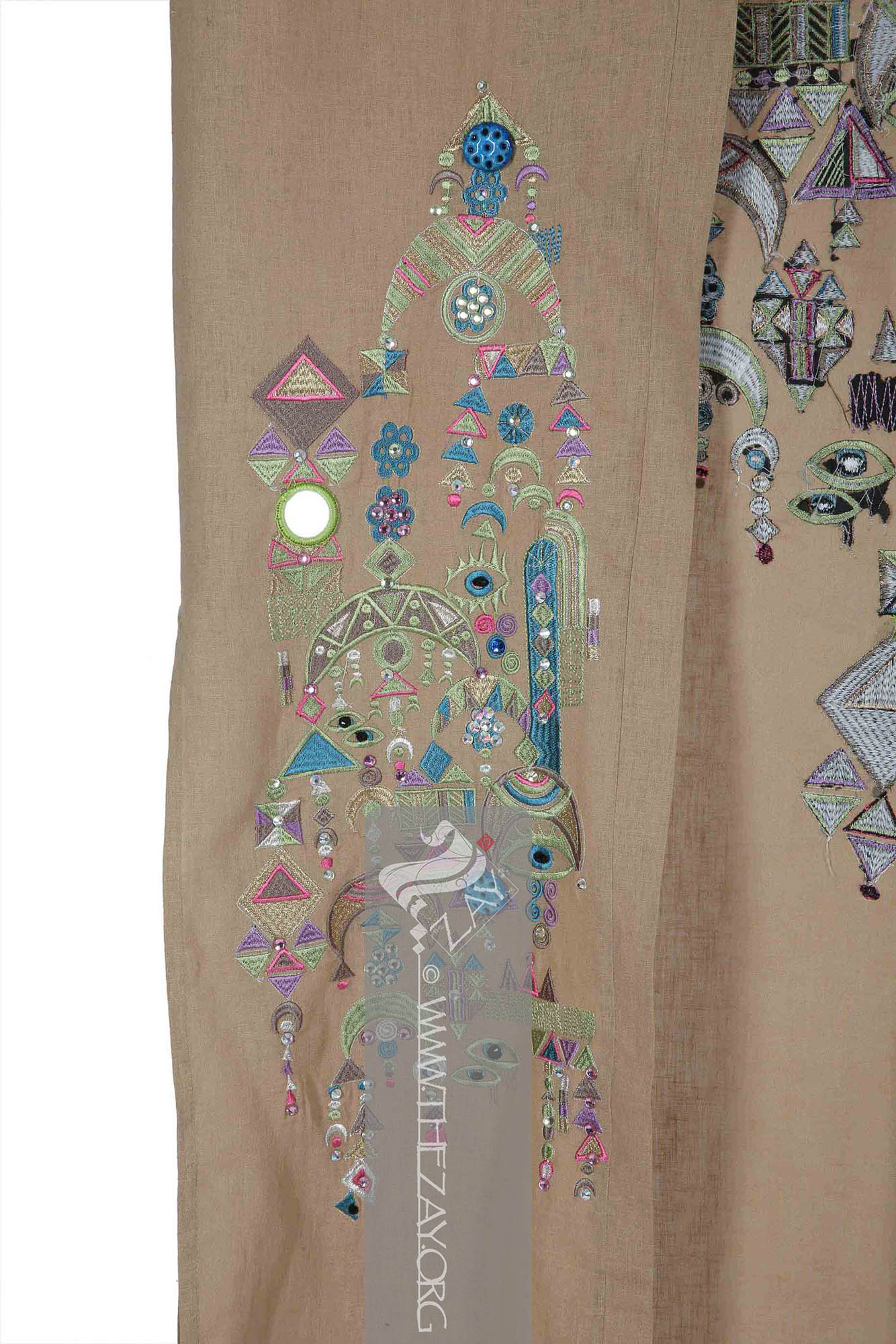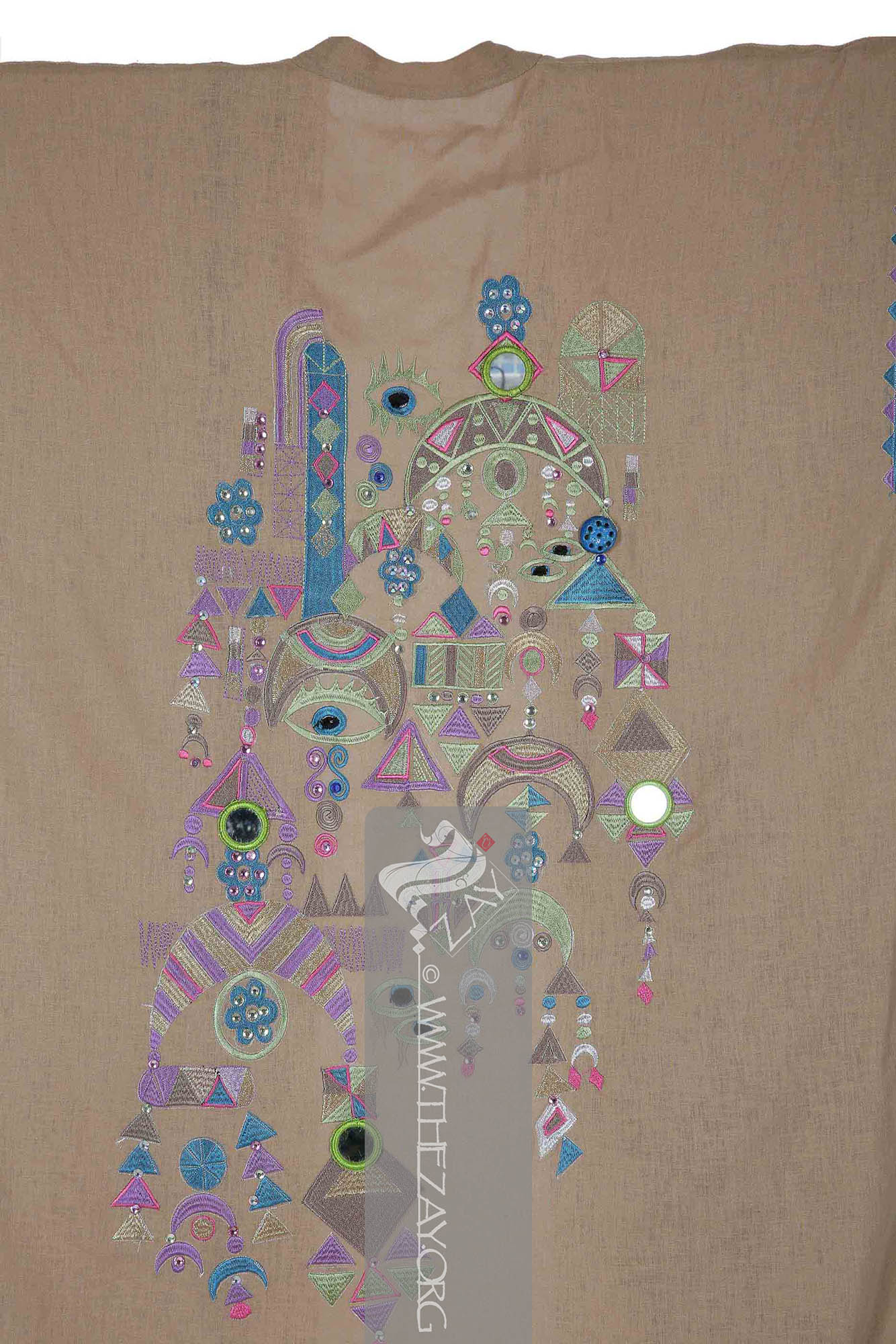












| Local Name | ‘Abayah |
| Object Category | Overgarment |
| Gender | Female |
| Date of object | c. 2015 |
| Place Of orgin | UAE |
| Region | UAE |
| Object Range | Syria, Iraq, Lebanon, Kuwait, Palestine, Jordan, Saudi Arabia, Egypt, Sudan, Cyprus, Bulgaria, Romania, Moldova, Greece, North Macedonia, Croatia, Serbia, Bosnia Herzegovina, Kosovo, Armenia, Azerbaijan, Georgia, et al. |
| Dimensions | Length: 130 cm Width: 136 cm |
| Materials | Silk Linen Metal Other |
| Technique | Machine Stitched Machine Embroidered |
| Color | |
| Motif | Abstract Floral Geometric |
| Provenance | Purchased, Iraqi fashion designer, UAE 2015 |
| Location | The Zay Zay: (Arabic: costume, Pl. azyaā’), a set of clothes in a style typical of a particular country or historical period. Initiative |
| Status | In Storage |
| ZI number | ZI2015.500879 IRAQ |
Object History
This piece was purchased by Dr. Reem Tariq
Ṭariq: (Arabic; Synonym: tulle_bi_talli; talli; badla; khus_dozi ), series of small metal knots made on a woven net ground as embellishment. The term is commonly used in the Levant Arab region specifically in Lebanon. Ṭariq: (Arabic; Synonym: tulle_bi_talli; talli; badla; khus_dozi ), series of small metal knots made on a woven net ground as embellishment. The term is commonly used in the Levant Arab region specifically in Lebanon.
Dr. Reem spotted the item displayed for purchase at a fair. The modern take on traditional attire and Iraqi symbols and iconography inspired her to purchase it. It is rather rare to come across a contemporary piece of good craftsmanship with such thoughtful reinterpretation of traditional style, motifs, and patterns, thus making a good example to be included in the collection.
Object Features
This is a woman’s front-opened linen robe (‘abayah ‘Abāyah: (Arabic: cloak, Pl. ‘abāyāt, or ‘Ibī. In Classical Arabic: ‘abā’ah, pl: ‘abā’āt, synonyms: ‘Abā, ‘abāh, ‘abāt, dafah Daffah : (Arabic: side, synonyms: ‘Abā, ‘abāyah, ‘abāh, ‘abāt, bisht or mishlaḥ), long, wide, and sleeveless outer cloak worn in public by both sexes. In time this article of dress evolved and changed in shape, style, and function., bisht, or mishlaḥ), long, wide, and sleeveless outer cloak worn in public by both sexes. In time this article of dress evolved and changed in shape, style, and function.). It features loose full sleeves and side slits. The ‘abayah ‘Abāyah: (Arabic: cloak, Pl. ‘abāyāt, or ‘Ibī. In Classical Arabic: ‘abā’ah, pl: ‘abā’āt, synonyms: ‘Abā, ‘abāh, ‘abāt, dafah Daffah : (Arabic: side, synonyms: ‘Abā, ‘abāyah, ‘abāh, ‘abāt, bisht or mishlaḥ), long, wide, and sleeveless outer cloak worn in public by both sexes. In time this article of dress evolved and changed in shape, style, and function., bisht, or mishlaḥ), long, wide, and sleeveless outer cloak worn in public by both sexes. In time this article of dress evolved and changed in shape, style, and function. displays an arrangement of abstract geometric and floral motifs embroidered with a variety of materials.
The field of the ‘abayah ‘Abāyah: (Arabic: cloak, Pl. ‘abāyāt, or ‘Ibī. In Classical Arabic: ‘abā’ah, pl: ‘abā’āt, synonyms: ‘Abā, ‘abāh, ‘abāt, dafah Daffah : (Arabic: side, synonyms: ‘Abā, ‘abāyah, ‘abāh, ‘abāt, bisht or mishlaḥ), long, wide, and sleeveless outer cloak worn in public by both sexes. In time this article of dress evolved and changed in shape, style, and function., bisht, or mishlaḥ), long, wide, and sleeveless outer cloak worn in public by both sexes. In time this article of dress evolved and changed in shape, style, and function. is embellished with embroidered geometric patterns heavy on talismanic symbolism common to Near and Middle Eastern cultures around the Mediterranean.
The hem and the seamlines are embellished with long rows of triangular repeats along a thin straight line. These triangular patterns are filled with silk floss
Floss: (Old French: flosche – nap of velvet), is a type of silk fibre obtained from the cocoons of wild silkworms. It is characterized by its long, fluffy fibers that are not tightly woven, making it ideal for use in various textile applications such as embroidery, lace-making, and sewing. threads of different colours – (turquoise
Turquoise: (French: turquois – present day Türkiye; Synonyms: firuze
Firuze: (Persian: pērōzah – "victory", later Arabic: fayrūz; Synonyms: firuze, pheroza), is a naturally occurring opaque mineral mined in abundance in Khorasan province of Iran and has been used for making dye for centuries. , pheroza), is a naturally occurring opaque mineral mined in abundance in Khorasan province of Iran and has been used for making dye for centuries. The term is a derivative of the French word for the country Türkiye once called Turkey. ) blue, lavender, and brown – embroidered in (satin_stitch
Satin_stitch: (Synonym: Damask Stitch), is a type of flat embroidery stitch that creates a satin like smooth and shiny surface by closely spaced stitches, covering an entire area or shape.) style and outlined with thin lines of embroidered metal thread (kalabdun
Kalabdūn: (Hindustani: kalabattu / kalabattun gold or silver threads; or Dravidian and Sanskrit: pattu or patt – a kind of fine fibre or silk; or Sanskrit: kalavatu – fine material), the gold wire used in embroidery and other embellishments on textiles and fabrics.
One side of the front opening has an elaborate arrangement of multiple geometric and abstract patterns embellished using golden and silver kalabdun
Kalabdūn: (Hindustani: kalabattu / kalabattun gold or silver threads; or Dravidian and Sanskrit: pattu or patt – a kind of fine fibre or silk; or Sanskrit: kalavatu – fine material), the gold wire used in embroidery and other embellishments on textiles and fabrics.
A similar arrangement is incorporated at the back (yoke Yoke: (Synonym: Bodice_Yoke), a structured pattern fitted at the shoulders defining the structure of women’s garments. Introduced in c. 1880s it defines the transition between the upper and lower parts of the garments and can now be found stitched-in where the blouse is separated from the skirt by a horizontal seam. ) of the piece, but on a larger scale.
The patterns include the eyes, possibly a derivative of the ‘eye of Horus’, the upturned crescent moon, double S or serpent or worm, the triangular and rhomboidal patterns, and some floral patterns too.
Common to various ancient Middle Eastern and Mediterranean societies, such as ancient Egypt and Greece, as well as Mesopotamia, these patterns have been later adopted and incorporated within the Judeo-Christian-Islamic faith and societies of the region.
Links
Charuga: (Possibly Kurdish), a mantle-like embroidered women’s traditional garment from the Qaraqosh region in northern Iraq, traditionally fastened at the shoulder. Historically worn by field workers, it helped conceal dust and dirt, making them less visible during labour, it is a festive garment worn sparingly during festivals and other special occasions.
from Northern Iraq Has Arrived at the TRC!, www.trc-leiden.nl/trc/index.php/en/blog/1378-the-charugaCharuga: (Possibly Kurdish), a mantle-like embroidered women’s traditional garment from the Qaraqosh region in northern Iraq, traditionally fastened at the shoulder. Historically worn by field workers, it helped conceal dust and dirt, making them less visible during labour, it is a festive garment worn sparingly during festivals and other special occasions.
-from-northern-iraq-has-arrvied-at-the-trc. Accessed 29 Jan. 2024.